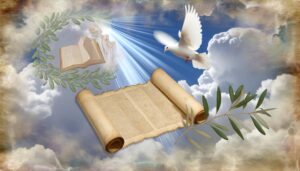12 Days of Christmas Biblical Meaning Bible Verse: Explained
The ’12 Days of Christmas’ song, often seen as a lighthearted holiday tune, is rich with biblical symbolism and Christian teachings. Each day’s gift represents elements of faith, such as the Partridge in a Pear Tree symbolizing Jesus Christ and the Two Turtle Doves referencing the Old and New Scriptures.
Further, theological virtues like the Three French Hens (faith, hope, charity) and the fruits of the Spirit are mentioned, enriching the song with spiritual meaning. These layers of symbolism underscore foundational aspects of Christian theology and practice.
To gain deeper insights into each symbol’s significance, continue exploring their scriptural foundations and thematic meanings.
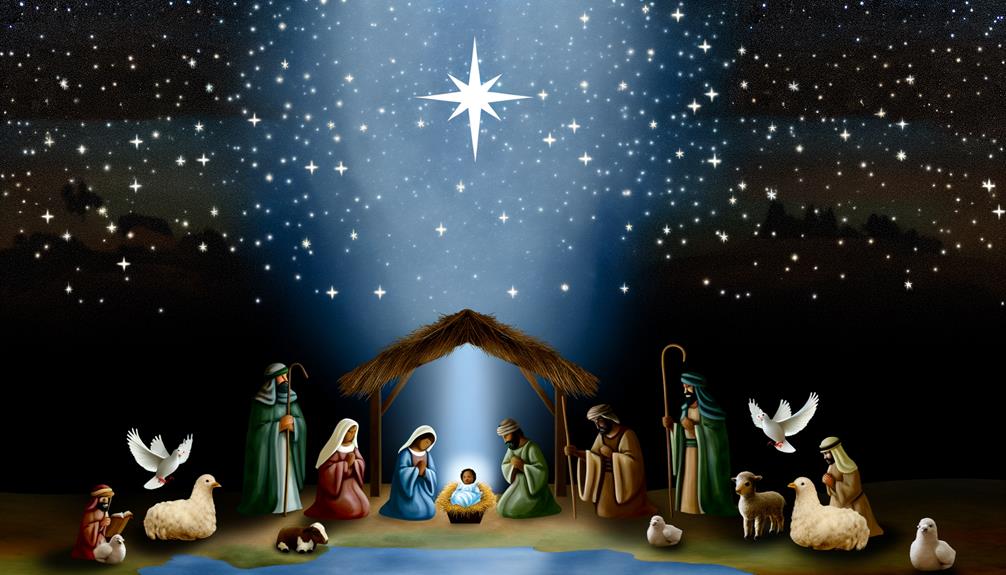
Key Takeaways
- The “Partridge in a Pear Tree” symbolizes Jesus Christ, referencing His protective sacrifice.
- “Two Turtle Doves” represent the harmony of the Old and New Testaments in Christian tradition.
- “Five Golden Rings” correspond to the Pentateuch, the first five books of the Bible.
- “Ten Lords A-Leaping” symbolize the Ten Commandments, ethical guidelines for believers.
12 Days of Christmas: Biblical Meaning and Bible Verses Explained
| Day | Gift in the Song | Biblical Meaning | Bible Verse |
|---|---|---|---|
| 1 | Partridge in a Pear Tree | Jesus Christ as the sacrificial lamb | John 3:16 |
| 2 | Two Turtle Doves | Old and New Testaments | 2 Timothy 3:16-17 |
| 3 | Three French Hens | Faith, Hope, and Love | 1 Corinthians 13:13 |
| 4 | Four Calling Birds | The Four Gospels (Matthew, Mark, Luke, John) | Matthew 28:19-20 |
| 5 | Five Golden Rings | The first five books of the Bible (The Pentateuch) | Genesis 1:1 |
| 6 | Six Geese a-Laying | Six days of Creation | Genesis 1:31 |
| 7 | Seven Swans a-Swimming | Seven gifts of the Holy Spirit | Isaiah 11:2-3 |
| 8 | Eight Maids a-Milking | The Eight Beatitudes | Matthew 5:3-12 |
| 9 | Nine Ladies Dancing | The nine fruits of the Holy Spirit | Galatians 5:22-23 |
| 10 | Ten Lords a-Leaping | The Ten Commandments | Exodus 20:1-17 |
| 11 | Eleven Pipers Piping | The eleven faithful Apostles | Luke 6:13-16 |
| 12 | Twelve Drummers Drumming | The twelve points of belief in the Apostles’ Creed | Romans 12:12 |
First Day: Partridge in a Pear Tree
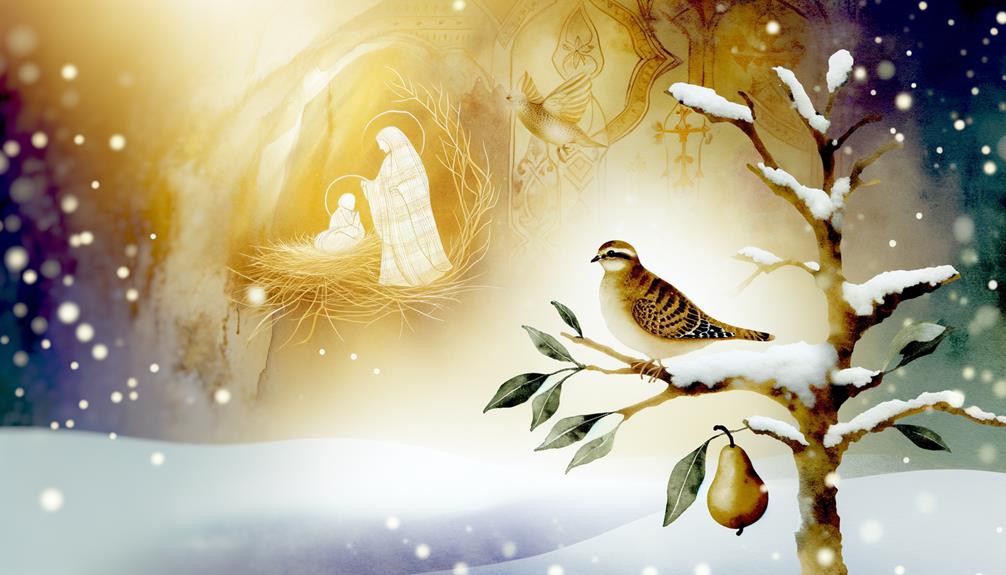
The ‘Partridge in a Pear Tree’ on the first day of Christmas is often interpreted within Christian tradition as a symbolic representation of Jesus Christ.
This symbolism is rooted in the protective behavior of the partridge, which is known to feign injury to draw predators away from its young, akin to Christ’s sacrifice for humanity.
Additionally, the pear tree itself can be seen as a metaphor for the cross, linking the imagery of the song to the central tenet of Christian faith—the crucifixion.
This association is further enriched by the partridge’s solitary nature, signifying the singularity of Christ’s role as the savior.
Consequently, the first gift in the song encapsulates themes of protection, sacrifice, and salvation.
Second Day: Two Turtle Doves

Representing the Old and New Scriptures, the two turtle doves on the second day of Christmas symbolize the harmony and continuity of the Christian biblical tradition.
This symbolic pairing reflects the dual foundations of the Christian faith: the Old Covenant, which sets forth the law, prophecy, and agreement, and the New Covenant, which fulfills and expands upon these themes through the life and teachings of Jesus Christ.
The turtle doves, often associated with sacrificial offerings (Leviticus 12:8), further underscore the elements of sacrifice and redemption central to both covenants.
Therefore, the two turtle doves encapsulate the theological interconnectedness and the seamless narrative that binds the entirety of the Christian Scriptures into a cohesive whole.
Third Day: Three French Hens

The ‘Three French Hens‘ on the third day of Christmas are often interpreted as symbols of faith, hope, and love, aligning with Paul’s theological virtues in 1 Corinthians 13:13.
This representation invites an analytical examination of their deeper theological significance, particularly within the context of Christian doctrine.
Additionally, exploring the biblical references and insights related to these virtues can illuminate how they encapsulate core tenets of the faith.
Symbolism of Three Hens
In the context of the ’12 Days of Christmas,’ the three French hens are often interpreted as symbolizing the theological virtues of faith, hope, and charity. These virtues are foundational in Christian theology and serve as pillars for spiritual development and moral integrity.
The choice of hens, specifically French hens, may evoke notions of value and rarity, underscoring the preciousness of these virtues.
- Faith: Represents trust in God’s promises and divine providence.
- Hope: Embodies the expectation of eternal salvation and divine assistance.
- Charity: Signifies selfless love and compassion toward others.
- Symbolic Value: Hens, as nurturing creatures, reflect the nurturing aspect of these virtues.
This symbolism enriches the spiritual depth of the Christmas narrative.
Theological Significance Explained
Exploring the theological significance of the third day in the ’12 Days of Christmas’ reveals profound insights into the virtues of faith, hope, and charity, symbolized by the three French hens.
These virtues, integral to Christian doctrine, are often considered the foundational pillars of a devout life. Faith represents trust in God’s promises, hope embodies the anticipation of divine fulfillment, and charity signifies selfless love towards others.
The three French hens, consequently, serve as a mnemonic for these theological virtues, urging believers to internalize and practice them. This symbolic representation underscores the importance of these virtues in fostering spiritual growth and aligning one’s life with Christian teachings, thus enriching the faithful’s understanding and observance of the holiday season.
Biblical References and Insights
Scriptural allusions to faith, hope, and charity can be found throughout the Bible, offering a rich tapestry of references that elucidate the significance of the three French hens in the ’12 Days of Christmas. ‘ This triad is often interpreted as representing the theological virtues mentioned in 1 Corinthians 13:13, which states, ‘And now these three remain: faith, hope and love. But the greatest of these is love. ‘ Bible interpretations and wisdom also tie the three French hens to other biblical figures and stories, such as the three wise men who brought gifts to the baby Jesus, and the three disciples who accompanied Jesus in the Garden of Gethsemane. These deep connections illustrate the layered significance of the ’12 Days of Christmas’ and the depth of meaning that can be found within its seemingly simple lyrics.
Faith: Hebrews 11:1 – ‘Now faith is the assurance of things hoped for, the conviction of things not seen.’
Hope: Romans 15:13 – ‘May the God of hope fill you with all joy and peace.’
Charity (Love): 1 John 4:8 – ‘Whoever does not love does not know God, because God is love.’
Symbolism: The three French hens signify these enduring virtues.
Exegesis: This aligns with the song’s deeper Christian meanings.
Fourth Day: Four Calling Birds

The ‘four calling birds‘ in the traditional Christmas carol are often interpreted as representing the four Evangelists who authored the canonical Gospels: Matthew, Mark, Luke, and John.
This interpretation aligns with the symbolic significance of birds in biblical literature, often seen as messengers of divine truth.
Each Evangelist presents a unique perspective of Christ’s life and teachings, contributing to a thorough understanding of the Gospel. Matthew emphasizes Jesus’ fulfillment of Old Covenant prophecies, Mark portrays the suffering servant, Luke highlights Jesus’ compassion for the marginalized, and John reveals His divine nature.
As a result, the ‘four calling birds’ serve as metaphors for the dissemination of the Gospel message, calling humanity to faith and deeper comprehension of divine revelation.
Fifth Day: Five Golden Rings

Following the symbolic significance of the four calling birds, the fifth day’s mention of ‘five golden rings’ can be interpreted as representing the Pentateuch, the first five books of the Old Scriptures, which lay the foundational truths of Judeo-Christian theology. These texts encompass the essential narratives and laws that shape religious doctrine and moral ethos.
- Genesis: Chronicles creation, humanity’s fall, and the patriarchal narratives.
- Exodus: Details the Israelites’ enslavement and liberation, highlighting divine intervention.
- Leviticus: Contains laws and rituals central to worship and holiness.
- Numbers: Records the wilderness wanderings and census of the tribes.
This interpretation aligns the ‘five golden rings’ with critical theological constructs.
Sixth Day: Six Geese A-Laying

In Christian symbolism, the six geese a-laying are often interpreted to signify the six days of creation as outlined in the book of Genesis. This imagery underscores the theological concept of God’s creative power and order. Each egg laid by the geese can be seen as a representation of life and new beginnings, echoing the divine act of creation.
| Day | Creation Event |
|---|---|
| 1 | Light |
| 2 | Sky and Waters |
| 3 | Land and Vegetation |
| 4 | Sun, Moon, and Stars |
| 5 | Birds and Marine Life |
| 6 | Animals and Humankind |
Understanding this symbolism invites reflection upon the intricate and purposeful design attributed to the Creator, emphasizing a foundational narrative in Christian theology.
Seventh Day: Seven Swans A-Swimming

The seventh day’s gift of ‘seven swans a-swimming’ is rich with symbolic resonance, often interpreted as representing the seven gifts of the Holy Spirit as outlined in the Book of Isaiah 11:2-3.
The elegance and grace of the swans may also signify the transformative power of these spiritual gifts, which guide believers in their faith journey.
This symbolism invites an exploration of how these gifts—wisdom, understanding, counsel, might, knowledge, piety, and fear of the Lord—manifest in the lives of the faithful.
Symbolism of Seven Swans
Representing grace, purity, and transformation, the seven swans a-swimming on the seventh day of Christmas are often interpreted as emblematic of the seven gifts of the Holy Spirit in Christian theology. This symbolic interpretation aligns with the swan’s traditional associations in various cultures and religious contexts. Swans, revered for their elegance and serene demeanor, mirror the transformative journey of spiritual sanctification.
- Grace: Swans symbolize divine grace, reflecting the unmerited favor bestowed upon believers.
- Purity: Their white plumage signifies spiritual purity and righteousness.
- Transformation: The swan’s lifecycle, especially its change from cygnet to adult, parallels spiritual growth.
- Serenity: Swans’ tranquil nature embodies inner peace, a hallmark of spiritual maturity.
- Elegance: Their graceful movement across water exemplifies the effortless flow of divine wisdom and guidance.
Gifts of the Spirit
Scholars often interpret the seven swans a-swimming in the ‘Twelve Days of Christmas’ as a representation of the seven gifts of the Holy Spirit, which are wisdom, understanding, counsel, fortitude, knowledge, piety, and fear of the Lord.
These gifts, enumerated in Isaiah 11:2-3, are seen as essential spiritual endowments bestowed upon believers to aid in their spiritual journey and moral discernment.
- Wisdom enables sound judgment; understanding allows insight into divine mysteries.
- Counsel provides guidance, while fortitude grants courage.
- Knowledge fosters a deeper awareness of God, piety nurtures reverence, and fear of the Lord instills awe and respect for the Divine.
Collectively, these gifts are foundational for a robust and devout Christian life.
Eighth Day: Eight Maids A-Milking
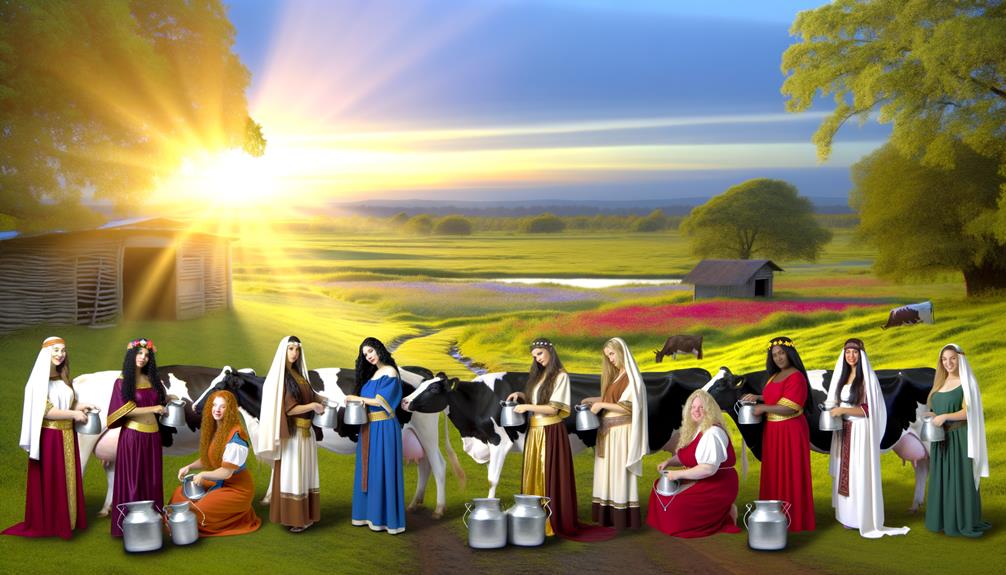
In examining the significance of the ‘Eight Maids A-Milking,’ it becomes evident that the representation of this verse is deeply rooted in Christian symbolism and theology. This verse is often interpreted as a reference to the Beatitudes, the eight blessings recounted by Jesus in the Sermon on the Mount. The imagery of maids engaged in milking symbolizes humility and service, reflecting the virtues extolled in the Beatitudes.
Key aspects include:
- Humility: Maids performing a humble task signify modesty.
- Service: Milking as a nurturing, life-sustaining act.
- Blessings: Correspondence to the eight Beatitudes.
- Equality: The maids symbolize the inclusiveness of God’s kingdom.
This imagery enriches our understanding of spiritual virtues and divine provision.
Ninth Day: Nine Ladies Dancing

The ‘Nine Ladies Dancing‘ in the traditional carol is often interpreted as a symbol of the nine fruits of the Holy Spirit as enumerated by the Apostle Paul in his Epistle to the Galatians.
These fruits, listed in Galatians 5:22-23, include love, joy, peace, patience, kindness, goodness, faithfulness, gentleness, and self-control.
The imagery of dancing ladies can be seen as a representation of the vivacity and joy that these spiritual gifts bring to a believer’s life.
The act of dancing, often associated with celebration and exuberance, aptly illustrates the transformative and uplifting power of the Holy Spirit’s presence.
Consequently, this verse underscores the integral role of spiritual virtues in the Christian faith.
Tenth Day: Ten Lords A-Leaping

Representing the Ten Commandments given by God to Moses on Mount Sinai, the ‘Ten Lords A-Leaping’ in the carol encapsulate the foundational ethical guidelines that underpin Judeo-Christian moral conduct.
These commandments serve as a moral compass, guiding believers in their daily lives and interactions. The metaphor of ‘lords’—figures of authority—leaping suggests a joyful adherence to these divine laws.
The Ten Commandments encompass:
- Monotheism: Recognizing one God.
- Reverence: Honoring God’s name.
- Sabbath: Observing a day of rest.
- Family: Respecting parental authority.
Analyzing this symbolism reveals how integral these divine injunctions are to the believer’s ethical framework and spiritual devotion.
Eleventh Day: Eleven Pipers Piping
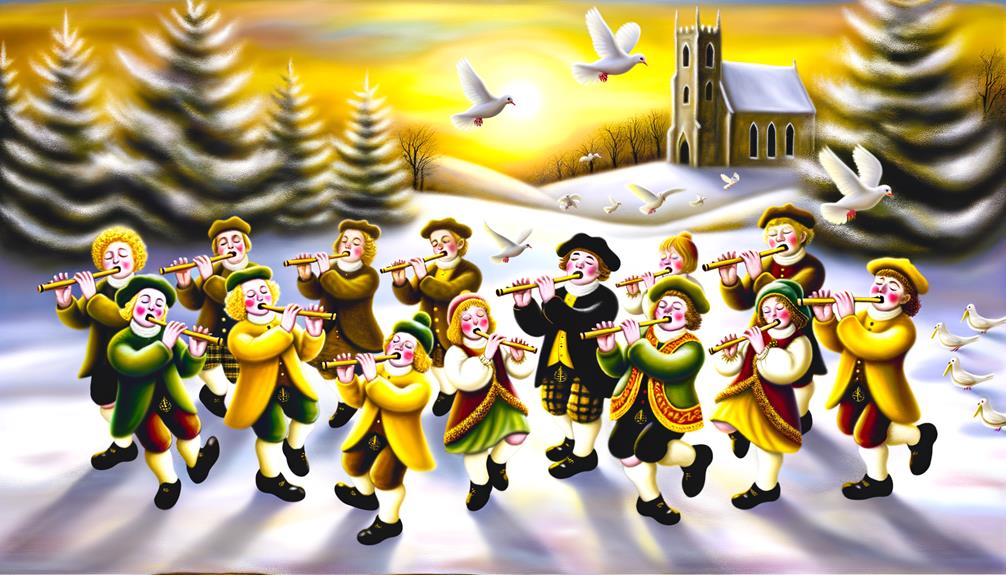
The eleventh day of Christmas, symbolized by eleven pipers piping, is often interpreted to represent the eleven faithful apostles who continued to proclaim the gospel after Judas’ betrayal.
This imagery underscores the apostles’ role in spreading divine teachings and maintaining the early Christian church’s doctrinal integrity.
Their faithful proclamation serves as a witness to their unwavering commitment to disseminating Christ’s message.
Apostles’ Faithful Proclamation
Eleven pipers piping traditionally symbolize the eleven faithful apostles who ardently proclaimed the teachings of Christ.
These apostles, excluding Judas Iscariot, carried forth the message of the Gospel with unwavering dedication. Their steadfast commitment is highlighted through various New scriptures passages, underscoring their role in the early Christian Church.
Key aspects of their proclamation include:
- Witnessing the Resurrection: The apostles bore witness to Christ’s resurrection, a cornerstone of Christian faith.
- Preaching with Boldness: Despite persecution, they preached with courage and conviction.
- Performing Miracles: Their miracles served as a proof of divine authority.
- Writing Epistles: Their letters form a significant part of the New scriptures canon.
This understanding emphasizes their pivotal role in disseminating Christ’s teachings.
Spreading Divine Teachings
Building upon the apostles’ unwavering proclamation, the symbolism of the eleven pipers piping encapsulates the dissemination of divine teachings through their relentless dedication. This imagery reflects the apostolic mission to spread the gospel, resonating through the harmonious and persistent efforts of the eleven faithful disciples who carried forth Christ’s teachings. The act of piping, akin to calling out, signifies the clarion call of truth and wisdom, echoing through generations.
| Apostle | Key Contribution |
|---|---|
| Peter | Foundation of the Church |
| John | Revelation and Gospel |
| James | Leadership in Jerusalem |
| Andrew | Evangelism in Asia Minor |
The table above delineates the apostles’ roles, underscoring their integral part in the propagation of divine wisdom.
Twelfth Day: Twelve Drummers Drumming

Symbolizing the twelve points of doctrine in the Apostles’ Creed, the ‘twelve drummers drumming’ on the twelfth day of Christmas encapsulates the foundational beliefs of the Christian faith. Each drummer represents a core tenet that undergirds the creed, emphasizing the importance of doctrinal purity and theological integrity within Christendom.
The Apostles’ Creed serves as a concise summary of essential Christian doctrine, revered across various denominations.
- Belief in God the Father Almighty, Creator of heaven and earth.
- Belief in Jesus Christ, His only Son, our Lord.
- Jesus’ suffering under Pontius Pilate, crucifixion, death, and burial.
- Jesus’ resurrection on the third day.
These points form an integral part of Christian orthodoxy and continue to guide the faithful.
Conclusion
The ’12 Days of Christmas’ song is laden with symbolic Christian references, each representing foundational elements of the faith.
From the partridge symbolizing Christ to the twelve drummers embodying the Apostles’ teachings, the gifts serve as mnemonic devices for biblical principles.
This layering of meaning transforms the carol into a tapestry of faith, weaving together doctrinal teachings with festive tradition.
By examining each day’s gift, one uncovers a deeper, exegetical understanding of religious heritage and biblical literacy.

